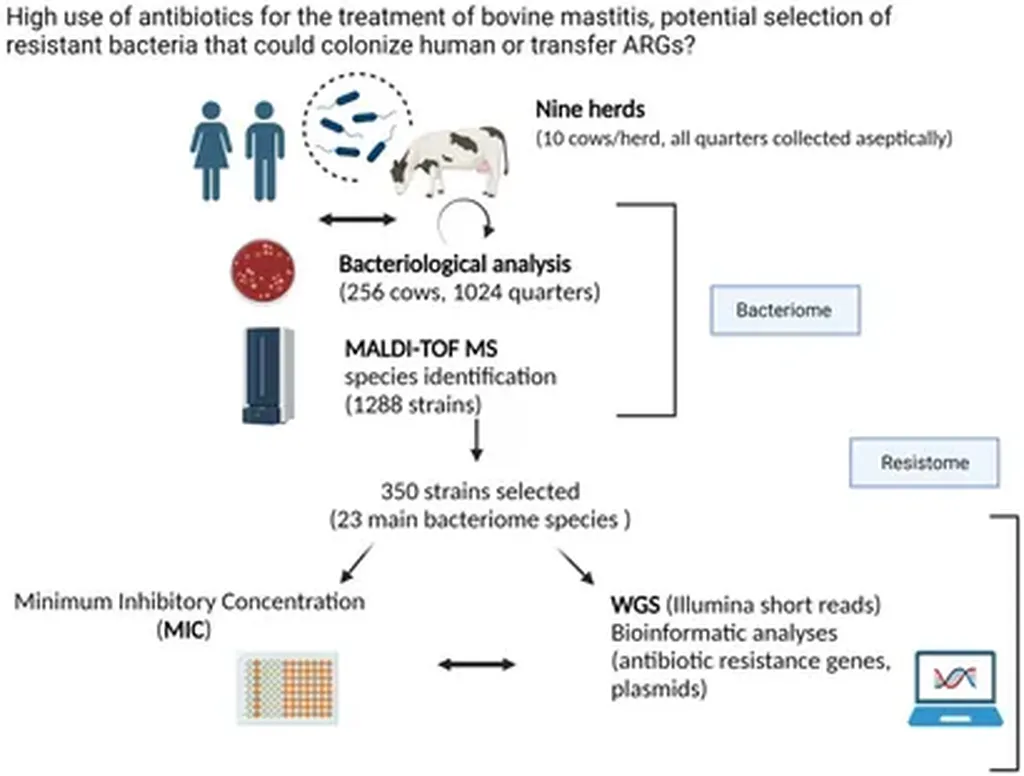In a groundbreaking study published in *Frontiers in Veterinary Science* (translated to English as *Frontiers in Animal Science*), researchers have employed advanced metatranscriptomics techniques to uncover the molecular signatures of transcriptionally active pathogens associated with bovine mastitis. This multi-etiological disease, which affects dairy cattle worldwide, is driven by complex microbial consortia. However, the transcriptional activity of these pathogens and their underlying molecular mechanisms have remained largely unexplored until now.
Led by T. Naveenprasath from the National Institute of Animal Biotechnology in Hyderabad, India, the study utilized publicly available RNA sequencing (RNA-Seq) datasets to identify transcriptionally active pathogens and their gene expression signatures. By analyzing unmapped reads—those not mapped to the bovine genome—the researchers identified 25 transcriptionally active pathogenic genera, accounting for 8,995 sequences from approximately 500 bacterial strains of different species.
One of the major findings of the study is the identification of emerging pathogens such as Pseudomonas, Stenotrophomonas, Comamonas, and Sphingomonas, which are actively contributing to disease development alongside well-known pathogens. “This discovery is significant because it highlights the complexity of bovine mastitis and the need for a more comprehensive understanding of the microbial communities involved,” said Naveenprasath.
The study also revealed the expression profiling of 4,121 virulence proteins, 484 peptidases, 432 secretory proteins, and 74 antimicrobial resistance genes. These findings provide valuable insights into the molecular mechanisms underlying the disease and could pave the way for the development of more effective diagnostic tools and therapeutic strategies.
Another notable discovery was the identification of numerous hypothetical proteins in Staphylococcus (112), Mycoplasma (69), and Escherichia (32). These proteins represent potential sources for diagnostics and multi-epitope vaccine candidates, offering new avenues for combating bovine mastitis.
The researchers also observed negative correlations between beneficial bacteria (Blautia, Bacillus, Lactobacillus) and pathogenic species in microbial co-occurrence interaction networks. This suggests opportunities for microbiome-based therapeutic strategies to treat subclinical mastitis. “Understanding these interactions is crucial for developing targeted treatments that can restore microbial balance and improve animal health,” explained Naveenprasath.
The study demonstrates the advantages of the metatranscriptomics approach and the use of publicly available dual RNA-Seq datasets in unraveling the complexity of polymicrobial infectious diseases. This research not only advances our understanding of bovine mastitis but also has significant implications for the dairy industry, which faces substantial economic losses due to this disease.
As the global demand for dairy products continues to rise, the need for effective strategies to combat bovine mastitis becomes increasingly urgent. This study provides a foundation for future research and development in this area, offering hope for more sustainable and profitable dairy farming practices.
In summary, the findings of this study highlight the importance of metatranscriptomics in uncovering the molecular signatures of transcriptionally active pathogens and their role in bovine mastitis. The identification of emerging pathogens, virulence proteins, and antimicrobial resistance genes, along with the potential for microbiome-based therapies, offers new avenues for combating this complex disease. This research not only advances our understanding of bovine mastitis but also has significant implications for the dairy industry, paving the way for more effective diagnostic tools, therapeutic strategies, and sustainable farming practices.

